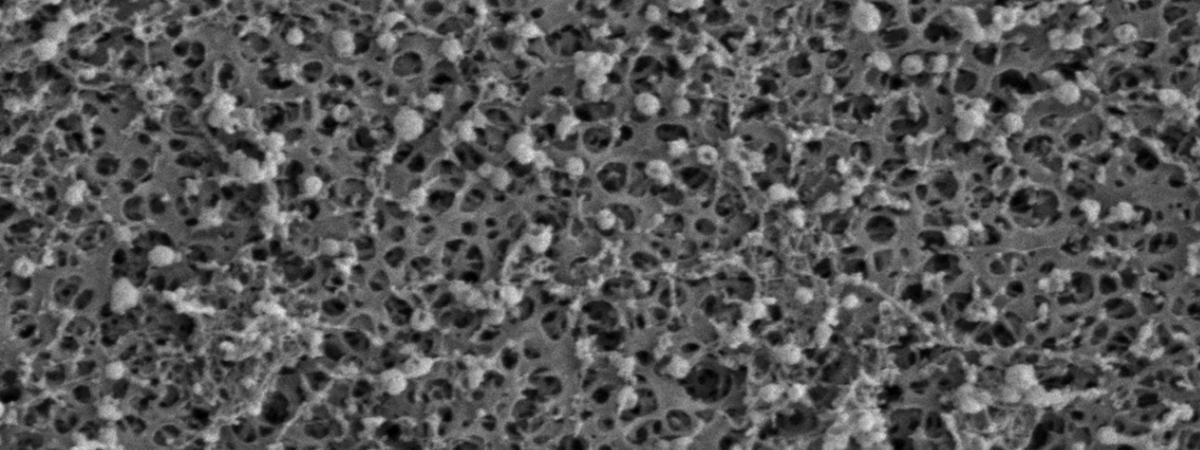Platform Enhances Purity and Reproducibility of Extracellular Vesicle Proteomics
Low-cost, high-throughput method improves purity and reproducibility of EV-based proteomics
Ghent, 07 July 2025 – A group of researchers at the VIB-UGent Center for Medical Biotechnology has developed a new platform to isolate and analyse extracellular vesicles (EVs), nanosized particles secreted by cells and playing a role in cellular communication and disease development. Called FAEVEr, the method increases the throughput of EV enrichment and is significantly more cost-efficient than existing methods. The study was published in the Journal of Extracellular Vesicles.
Extracellular Vesicles (EVs) are small particles that carry proteins, RNA, and other biomolecules from their cell of origin. They hold much promise for diagnostics and therapeutics, but isolating them from complex biofluids at high purity and throughput remains a major challenge. EVs are incredibly small - between 30 and 150 nanometers in size. To capture these tiny containers of messengers, scientists need to rely on sophisticated equipment such as ultracentrifuges. Unfortunately, these traditional methods of EV enrichment are time-consuming and resource-intensive with relatively low throughput.
Now, researchers in the lab of Prof. Kris Gevaert at the VIB-UGent Center for Medical Biotechnology have developed a novel EV-enrichment method. Building on their earlier work published in Molecular & Cellular Proteomics (January 2025), they demonstrated the effectiveness of Filter-Aided Extracellular Vesicle Enrichment, or FAEVEr in enriching EVs from individual samples in a miniaturized and 96-well high-throughput format.

Cost-efficient and fast
The new platform promises a much faster and more affordable alternative to existing EV-enrichment methods. Using 96-well filter plates, FAEVEr enables a much higher throughput volume by parallel processing of samples in under 2 hours.
Essential to the FAEVEr method is the use of Tween-20, a mild and inexpensive detergent added during EV washing steps. Its inclusion proved critical for improving the purity of the EV proteome by preventing fouling of the filter membranes used to trap EVs and by breaking weak interactions between EVs and contaminating abundant proteins. Importantly, this improvement in purity does not require complex chemistry or costly reagents, making the method accessible for both labs and clinical research settings using standard lab equipment.
Dr. Jarne Pauwels, first author of the study: “We noticed that the addition of higher concentrations of Tween-20 led to a marked reduction in contaminating non-EV proteins and a significant increase in the identification of transmembrane proteins, a key metric in our studies.”

Doing clinicians a FAEVEr
This innovation paves the way for more reproducible EV-based proteomics and strengthens the foundation for future clinical applications of EVs in diagnostics.
“We hope this new approach can find its way into clinical practice”, adds Prof. Kris Gevaert, Director of the VIB-UGent Center for Medical Biotechnology. “FAEVEr lowers the barrier for EV enrichment and offers a significantly faster and much more cost-efficient approach to analyzing plasma or urine biopsies for biomarkers. We hope this new technology can contribute to faster diagnoses for patients.”
The method is already being applied in collaborations focused on prostate cancer, where enriched EV analysis may help identify disease-specific protein signatures from a simple urine sample.
Publication
Pauwels et al. “A 96well ultrafiltration approach for the high-throughput proteome analysis of extracellular vesicles isolated from conditioned medium” Journal of Extracellular Vesicles, 2025.
Funding
The research team at the VIB-UGent Center for Medical Biotechnology was financially supported by FWO, the Ghent University Concerted Research Actions and the interuniversity BOF program.
Joran Lauwers
About the VIB-UGent Center for Medical Biotechnology
Research at the VIB-UGent Center for Medical Biotechnology can lead to more effective medicine. If we know the causes and mechanisms of a disease, we can then deal with it in a better way. This is much more efficient than treating the symptoms, which is how things are often done at the moment. The research helps to prevent, diagnose or treat diseases.



